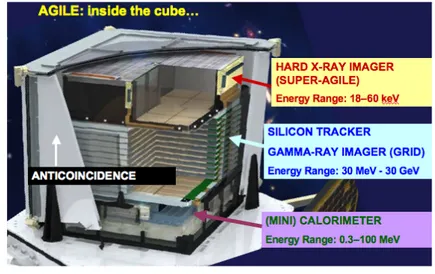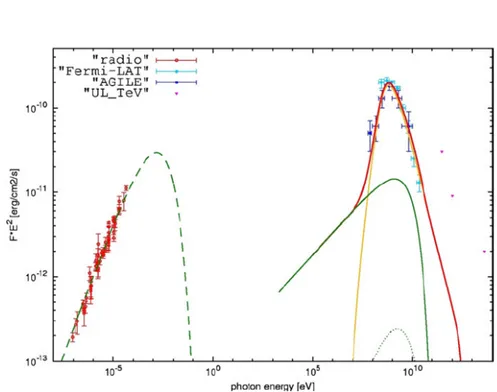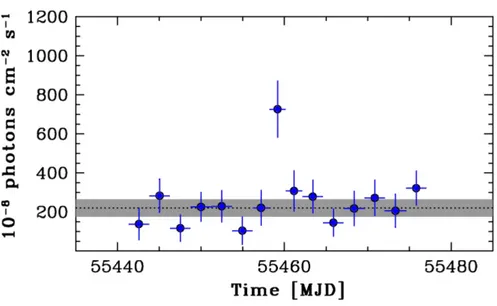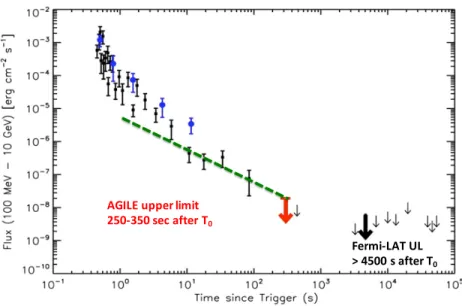PITTORI, Carlotta
Authors
10.1142/S0218271818440157
DOI
http://hdl.handle.net/20.500.12386/30556
Handle
INTERNATIONAL JOURNAL OF MODERN PHYSICS D
Journal
27
December 2, 2020 1:46 WSPC/INSTRUCTION FILE pittori˙c
International Journal of Modern Physics D © World Scientific Publishing Company
AGILE RESULTS on RELATIVISTIC OUTFLOWS above 100 MeV
CARLOTTA PITTORI∗
INAF-OAR and ASI Space Science Data Center Via del Politecnico snc, 00133 Rome, Italy
Received Day Month Year Revised Day Month Year
We give an overview of the AGILE γ-ray satellite highlights. AGILE is an Italian Space Agency (ASI) mission devoted to observations in the 30 MeV - 50 GeV γ-ray energy range, with simultaneous X-ray imaging in the 18-60 keV band. Launched in April 2007, the AGILE satellite has completed its tenth year of operations in orbit, and it is sub-stantially contributing to improve our knowledge of the high-energy sky. Emission from cosmic sources at energies above 100 MeV is intrinsically non-thermal, and the study of the wide variety of observed Galactic and extragalactic γ-ray sources provides a unique opportunity to test theories of particle acceleration and radiation processes in extreme conditions.
Keywords: Gamma rays: general; Acceleration of particles, Galactic and extragalactic objects and systems.
PACS numbers: 95.85.Pw, 95.55.Ka, 98.70.Rz, 98.38.Fs, 98.58.Fd.
1. Introduction
AGILE (Astro-rivelatore Gamma a Immagini LEggero)1is a γ-ray astrophysics
mis-sion of the Italian Space Agency (ASI), with INAF, INFN and CIFS participation. The satellite, launched on April 23, 2007, has completed its tenth year of opera-tions, and continues its mission with high efficiency. The AGILE scientific payload consists of three instruments with independent detection capability (see Fig. 1): the Gamma Ray Imager Detector (GRID) sensitive in the energy range 30 MeV–30 GeV, a Mini-Calorimeter (MCAL) sensitive in the energy range 350 keV to 100 MeV that works both as a slave of the GRID and as an autonomous detector for transient events, and a hard X-ray imager on top (Super-AGILE), sensitive in the energy range 18–60 keV.
High-energy astrophysics studies the non-thermal emission in the Universe, mainly coming from violent astrophysical environments near compact objects, such
∗on behalf of the AGILE Collaboration.
1
2 C. Pittori
Fig. 1. The AGILE payload.
as neutron stars and super-massive or stellar-size black holes. This branch of astro-physics has enjoyed rapid development in the past decades, and recent important results and progress were achieved by the space-based γ-ray AGILE1 and Fermi2
(NASA) satellites observations. Recent and unexpected discoveries of intense γ-ray transients at energies above 100 MeV on short timescales (< minutes, days) in dif-ferent astrophysical systems, both Galactic and extragalactic, challenge models of particle acceleration. High-energy astrophysics new lessons: the observation of brief and very bright flares of energetic γ-rays suggests that pairs are accelerated to PeV energies on short timescales. Such rapid intra-day accelerations cannot be driven by shocks, and they may highlight the role of the magnetic field, the importance of relativistic magnetic reconnection and plasma instabilities in astrophysical sources. Furthermore the compact objects emitting broad-band non-thermal electromag-netic radiation are also believed to be emitters of other multi-messenger signals, such as cosmic rays, neutrinos, and gravitational waves.
2. AGILE Science Highlights
We present here a selection of the main AGILE science highlights after ten years of operations, and some recent updates related to the search of electomagnetic counterparts of gravitational waves (GW).
In particular we reassume in Subsect. 2.1, 2.2 and 2.3 the three main discoveries for which AGILE will be remembered. In Subsect. 2.4 we present other important scientific results for which we think that AGILE should be remembered.
2.1. AGILE detections of microquasars in the Cygnus region
December 2, 2020 1:46 WSPC/INSTRUCTION FILE pittori˙c
AGILE results on relativistic outflows above 100 MeV 3
Fig. 2. Hard-X-ray flux from Cygnus X-3 as monitored by the Burst Alert Telescope (BAT) on board NASA’s Swift spacecraft, between 1 January 2008 and 30 June 2009. The red arrows mark the dates of major gamma-ray flares of Cygnus X-3 as detected by the AGILE instrument.3
X-3 in 2008 associated with a specific spectral state preceding a major radio jet ejection opened a new window of investigation of microquasars. AGILE detected for the first time several γ-ray flares above 100 MeV from Cygnus X-3 microquasar and also a weak persistent emission.3 Gamma-ray flares occur following a clear repetitive pattern, either in coincidence with low hard-X-ray fluxes or during transitions from low to high hard-X-ray fluxes, see Fig. 2, and usually appear before major radio flares. This important AGILE discovery published on the high-impact journal Nature has been subsequently confirmed on a Science paper by Fermi, which was also able to identify the 4.8 hours orbital period in γ-rays, securing unambigously the temporal signature of the binary system.4AGILE and
Fermi were able to answer a long-lasting question: Cygnus X-3 binary system is indeed able to accelerate particles up to relativistic energies and to emit γ-rays above 100 MeV.
• Cygnus X-1: Gamma-ray flaring activity for a source positionally consistent with Cygnus X-1 microquasar was reported twice by AGILE in 2010.5–7AGILE
extensive monitoring of Cygnus X-1 in the energy range 100 MeV - 3 GeV during the period 2007 July - 2009 October confirmed the existence of a spectral cutoff
4 C. Pittori
Fig. 3. Hadronic modeling of the broadband spectral energy distribution of the SNR W44 with radio data in red and gamma-ray data in blue.10The yellow curve shows the neutral pion emission from the accelerated proton distribution.
between 1-100 MeV during the typical hard X-ray spectral state of the source. However, even in this state, Cygnus X-1 is capable of producing episodes of ex-treme particle acceleration on 1-day timescales, and even shorter lived flares in the TeV range as detected by MAGIC in 2006 Albert2007. Gamma-ray flares of Cygnus X-1 detected by AGILE above 100 MeV were not immediately confimed by Fermi, and have been confirmed only after a later re-analisis of Fermi-LAT data.9
2.2. First evidence of cosmic-ray acceleration from AGILE observations of the SNR W44
Understanding the origin of cosmic rays is one of the most important issues of high-energy astrophysics, and galactic Supernova Remnants (SNR) are considered to be an ideal laboratory to study Cosmic-Ray acceleration. In the energy range just below 200 MeV, hadronic and leptonic emission spectra have a well distinct behavior due to a steepening of the hadronic spectrum due to the neutral pion emission, which is missing in the leptonic case. The AGILE-GRID instrument reaches its optimal sensitivity just at energies between 50 MeV and a few GeV, and it was the first to
December 2, 2020 1:46 WSPC/INSTRUCTION FILE pittori˙c
AGILE results on relativistic outflows above 100 MeV 5
Fig. 4. The Crab Nebula flare as observed by AGILE at energies above 100 MeV in September 2010.13
discover a clear indication of the so-called “pion bump” in the γ-ray emission from the supernova remnant W44.10 AGILE observations, combined with the observed multifrequency properties of the source, have been crucial to discriminate between theoretical models, and can be unambiguously attributed to accelerated protons interacting with nearby dense gas, see Fig. 3. This important AGILE result was reported in 10 and later confirmed by Fermi-LAT data in 11. Before AGILE and Fermi, a direct identification of proton acceleration sites in our Galaxy was elusive.
2.3. Crab Nebula variability
The surprising discovery by AGILE of variable γ-ray emission above 100 MeV from the Crab Nebula in Sept. 201012, 13 started a new era of investigation of the Crab
system. The 2012 Bruno Rossi International Prize has been awarded to the PI, Marco Tavani, and the AGILE team for this important and unexpected discovery, which was also confirmed one day later by Fermi.14, 15
Crab was considered to be an almost ideal standard candle, a nearly constant source (at a level of few percent) from optical to γ-ray energies, with possible long-term nebular flux variations over a few-year timescale reported in the hard X-ray range. On September 2010 AGILE detected a rapid γ-ray flare over a daily timescale, see Fig.4, and thanks to its rapid alert system, made the first public announcement on September 22, 2010.12 This finding was confirmed the next day by the Fermi Observatory.14 AGILE had also previoulsy detected a giant flare from the Crab
in October, 2007 during the initial Science Verification Period of the satellite, and in the First AGILE Catalog paper16 it was reported that anomalous episodic flux
6 C. Pittori
values observed from the Crab in 2007 were under investigation. We know now of several major γ-ray flares from the Crab Nebula detected by the AGILE-GRID and Fermi-LAT, up to October 2016.
Gamma-ray data provide evidence for particle acceleration mechanisms in neb-ular shock regions more efficient than previously expected from theoretical models. We estimate a recurrence rate for strong γ-ray flares of ∼ 1/year.
2.4. Other important AGILE scientific results
• PWN Vela-X: The AGILE detection of γ-ray emission from the Pulsar Wind Nebula (PWN) Vela-X, described in a Science paper,17has been the first
experi-mental confirmation of γ-ray emission (E> 100 MeV) from a pulsar wind nebula. This result constrains the particle population responsible for the GeV emission and establishes a class of γ-ray emitters that could account for a fraction of the unidentified galactic γ-ray sources. Subsequently the NASA Fermi satellite has confirmed the Vela-X γ-ray detection,18 and has also firmly identified about 9 other pulsar wind nebulae plus few other PWN candidates.19
• η-Carinae: AGILE has provided the first detection of a colliding wind binary (CWB) system above 100 MeV in the η-Carinae region.20 AGILE detected a
γ-ray source (1AGL J1043-5931, now 1AGLR J1044-5944) consistent with the position of the CWB massive system ηCar during the time period 2007 July -2009 January. A 2-day γ-ray flaring episode was also reported on 2008 Oct. 11-13, possibly related to a transient acceleration and radiation episode of the strongly variable shock in the system. A revised AGILE γ-ray source list in the complex Carina region has been published in 21.
• Bright γ-ray flaring blazars: As it has been observed by EGRET and confirmed by Fermi, AGILE detects only few objects with flux greater than 100 × 10−8 ph cm−2 s−1 above 100 MeV. Whether this is due to selection ef-fects or there is a subclass of blazars with peculiar characteristics is still an open question. Moreover AGILE observations have brought to light a more complex behaviour of blazars with respect to the standard models, indicating the presence of two emission components in any BL Lacs, and the possible contributions of an hot corona as source of seed photons for the External Compton in FSRQs. The study of multiwavelength correlations is the key to understand the structure of the inner jet and the origin of the seed photons for the Inverse Compton process. AGILE observations of γ-ray flares from FSRQs such as 3C 454.3 (see 22 and references therein), 3C 279 (see 23, 24 and references therein), PKS 1830-211(see 25 and references therein), 4C +21.35 (see 26 and previous AGILE Astronomer’s Telegrams), often extending up to TeV energies, with fast timescale variability of the order of hours or even minutes, together with their multi-wavelength behavior showing in general a very high Compton dominance, challenge simple one-zone leptonic theoretical models (see 27 and references therein).
December 2, 2020 1:46 WSPC/INSTRUCTION FILE pittori˙c
AGILE results on relativistic outflows above 100 MeV 7
Fermi-LAT UL > 4500 s after T0
AGILE upper limit 250-350 sec after T0
Fig. 5. The AGILE (blue circles) and Fermi-LAT (black squares) gamma-ray lightcurves of the short GRB090510 scaled in flux and time as if it originated at the GW event GW150914 luminosity distance. The AGILE-GRID upper limit to γ-ray emission above 100 MeV is shown in red, the corresponding Fermi-LAT upper limit is marked in black.
which triggered the study of the AGILE position error box field, and led to the subsequent discovery of the first “hidden black hole” MCW 656 in a Be star binary.28
• Terrestrial Gamma-Ray Flashes:
Surprises also came from the Earth atmosphere. The AGILE Minicalorimeter is also detecting Terrestrial Gamma-Ray Flashes (TGFs), intense and brief pulses of γ-rays originating in the Earth atmosphere, and associated with thunderstorm activity. TGFs last a few thousandths of a second, and produce γ-ray flashes up to 100 MeV, on timescales as low as < 5 ms.29 AGILE data have shown
for the first time that TGF cumulative spectrum at high energy deviates from a power law with exponential cutoff model and can be better fit with a broken power law with significant counts above background up to 100 MeV. The crucial AGILE contribution to TGF science is thus the discovery that the TGF spectrum extends well above 40 MeV, and that the high energy tail of the TGF spectrum is harder than expected.
2.5. AGILE and gravitational waves
The very fast AGILE ground segment alert system30, 31 has been recently further optimized for the search of electromagnetic counterparts of gravitational waves, al-lowing the AGILE Team to perform a full data reduction and the preliminary Quick Look scientific analysis only 25/30 minutes after the telemetry download from the
8 C. Pittori
spacecraft. The short GRB 09051032, 33has been considered a reference for poten-tial electromagnetic γ-ray emission that could be associated to a GW event, and its lightcurve has been used as a possible high-energy template counterpart of GW events,34, 35 In Fig. 5 we show in red the prompt AGILE upper limit in the case of
GW150914 compared to a rescaled gamma-ray light curve of GRB 090510 (originally at z = 0.9, scaled in flux and time corrected as if it originated at the GW150914 luminosity distance z = 0.09). The AGILE observations have been significant in providing the fastest response above 100 MeV to GW150914 and all to other GW events detected up to now with optimal gamma-ray sensitivity.35–37
The prospects for future follow-up gamma-ray observations of GW sources by AGILE are very promising.
Acknowledgments
The author would like to acknowledge the financial support of ASI under contract to INAF: ASI 2014-049-R.0 dedicated to SSDC.
References
1. Tavani, M., Barbiellini, G., Argan, A., et al. 2009, A. & A., 502, 995 2. Atwood, W.B.,Abdo, A.A., Ackermann, M., et al., 2009, ApJ, 697, 1071 3. Tavani, M. et al., 2009, Nature 462, 620-623
4. Abdo A. A., Ackermann M., Ajello M., et al., 2009a, Sci, 326, 1512 5. Bulgarelli, A. et al., 2010, ATel #2512
6. Sabatini, S. et al.,2010a, ATel #2715 7. Sabatini, S. et al., 2010b, ApJ 712, L10
8. Albert J., Aliu E., Anderhub H., et al., 2007, ApJ, 665, 51
9. Bodaghee, A., Tomsick, J. A., Pottschmidt, K., et al. 2013, ApJ, 775, 98 10. Giuliani, A. et al., 2011, ApJ 742, L30
11. Ackermann M., et al., 2013, Science, 339, 807 12. Tavani, M. et al., 2010, ATel #2855
13. Tavani, M. et al., 2011, Science Vol. 331, 736-739 14. Buehler, R. et al., 2010, ATel #2861
15. Abdo, A. A. et al., 2011, Science Vol. 331, 739 16. Pittori, C. et al., 2009, A. & A., 506, 1563
17. Pellizzoni, A., Trois, A., Tavani, M., et al. 2010, Science, 327, 663 18. A.A. Abdo et al., 2010, ApJ 713, 146-153
19. Acero, F., Ackermann, M., Ajello, M., et al. 2015, ApJS, 218, 23. 20. Tavani, M., Sabatini, S., Pian, E. et al. 2009, ApJ, 698, L142 21. Verrecchia, F., Pittori, C., Chen, A. W. et al. 2013 A. & A., 558, 137 22. Vercellone, S., Striani, E., Vittorini, V., et al. 2011, ApJ, 736, L38 23. Pittori, C. et al., 2018, to appear in ApJ.
24. Giuliani, A. et al., 2009, A. & A., 494, 509 25. Donnarumma, I. et al., 2011, ApJL, 736, L30
26. Verrecchia, F., Lucarelli, F., Pittori, C., et al. 2014, ATel #6733 27. Tavani, M., Vittorini, V., and Cavaliere, A. 2015, ApJ, 814, 51 28. Munar-Adrover, P., et al. 2016, ApJ, 829, 101
December 2, 2020 1:46 WSPC/INSTRUCTION FILE pittori˙c
AGILE results on relativistic outflows above 100 MeV 9
30. Pittori, C. 2013, Nuclear Physics B Proceedings Supplements, 239, 104 31. Bulgarelli, A., Trifoglio, M., Gianotti, F., et al. 2014, ApJ, 781, 19 32. Giuliani A., et al., 2010, ApJ, 708, L84
33. Ackermann M., et al., 2010, ApJ, 716, 1178 34. Ackermann, M., et al. 2016, ApJ, 823, L2
35. Tavani, M., Pittori, C., Verrecchia, F., et al. 2016, ApJL, 825, L4 36. Verrecchia, F., et al. 2017, ApJ, 847, L142
37. Verrecchia, F., et al. 2017, ApJ, 850, L142 38.




